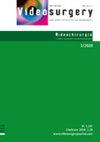前交叉韧带残端重建前交叉韧带
IF 1.6
4区 医学
Q2 SURGERY
引用次数: 6
摘要
前交叉韧带(ACL)损伤常导致膝关节疼痛和功能障碍,建议手术重建,临床效果良好,但术后本体感觉也容易下降。ACL残端保留ACL重建和非ACL保留ACL重建是两种手术选择。目的探讨保留ACLS在同种异体移植物重建中的效果。材料与方法30例患者回顾性分为A组,保留ACL的ACL重建;B组为非保留ACL的ACL重建组,并对其数据进行分析。评估两组膝关节功能(Lysholm评分和Tegner运动评分)和本体感觉功能,并以术后重建角度进行比较。结果30例患者平均随访20个月。A组平均Lysholm评分由术前55.7±11.6分提高至术后95.2±5.7分;B组由术前56.7±11.3分提高至术后94.6±7.2分。A组平均Tegner运动评分由术前2.4±0.7分提高至术后6.0±0.7分;B组由术前2.73±0.96分提高至术后6.24±0.48分;两组术后评分无明显差异。术后3、6、12个月,A组本体感觉优于B组(p < 0.05)。结论保留前交叉韧带重建效果良好,保留前交叉韧带有利于术后早期本体感觉恢复。本文章由计算机程序翻译,如有差异,请以英文原文为准。
Anterior cruciate ligament reconstruction using an anterior cruciate ligament stump
Introduction Anterior cruciate ligament (ACL) injury always leads to knee pain and dysfunction for which surgical reconstruction is recommended, with good clinical results, but decreased postoperative proprioception also tends to occur. ACL stump (ACLS)-retaining ACL reconstruction and non-ACLS-retaining ACL reconstruction are the two surgical options. Aim To investigate the efficacy of retaining the ACLS in allograft reconstruction. Material and methods Thirty patients were retrospectively assigned to group A, ACLS-retaining ACL reconstruction; and group B, non-ACLS-retaining ACL reconstruction, and their data were analyzed. The knee function (Lysholm score and Tegner motion score) and proprioceptive function of the two groups were assessed and compared by postoperative reconstruction angle. Results The 30 patients were followed up for a mean 20 months. The mean Lysholm score in group A increased from 55.7 ±11.6 points preoperatively to 95.2 ±5.7 points postoperatively; that in group B increased from 56.7 ±11.3 points preoperatively to 94.6 ±7.2 points postoperatively. The mean Tegner motion score in group A was increased from 2.4 ±0.7 points preoperatively to 6.0 ±0.7 points postoperatively; that in group B increased from 2.73 ±0.96 points preoperatively to 6.24 ±0.48 points postoperatively; the postoperative scores did not differ significantly between the two groups. The proprioception was better in group A than in group B at 3, 6, and 12 months postoperatively (p < 0.05). Conclusions ACLS-retaining ACL reconstruction has good efficacy and the retained ACLS can benefit postoperative proprioception recovery at an early stage.
求助全文
通过发布文献求助,成功后即可免费获取论文全文。
去求助
来源期刊
CiteScore
2.80
自引率
23.50%
发文量
48
审稿时长
12 weeks
期刊介绍:
Videosurgery and other miniinvasive techniques serves as a forum for exchange of multidisciplinary experiences in fields such as: surgery, gynaecology, urology, gastroenterology, neurosurgery, ENT surgery, cardiac surgery, anaesthesiology and radiology, as well as other branches of medicine dealing with miniinvasive techniques.

 求助内容:
求助内容: 应助结果提醒方式:
应助结果提醒方式:


